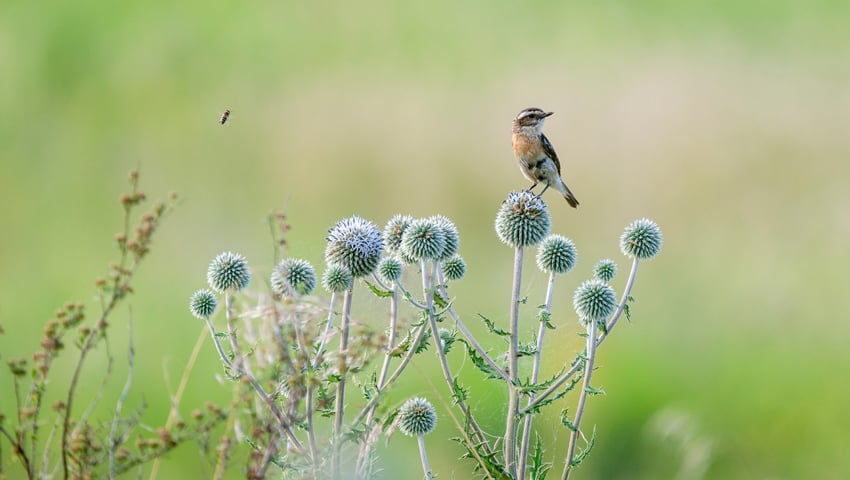New research, commissioned by the Foundation for Common Land and published by the RSPB, is providing hope for whinchat on Dartmoor, highlighting actions that could help to maintain breeding populations in one of the species’ last remaining southern strongholds.
Smaller than a robin, whinchats have striking plumage with a noticeable white eye stripe and orange throat and chest. The red listed bird has declined in the UK by 60 per cent between 1995 and 2022 and are now increasingly confined to the marginal uplands of Scotland, northern England, central Wales, the Isle of Man, Exmoor and Dartmoor.
The study assessed Dartmoor’s breeding bird data in order to identify why whinchats have disappeared from some areas but not others, in the hope of securing the future of this species across Dartmoor commons and informing conservation efforts across similar landscapes elsewhere.
The study found that a number of habitat features, including steep-sided valleys, mixed bracken, heather and bilberry, and a light tree cover, are favoured by whinchat on their return to the UK from Africa each summer to breed. In areas where these features had been lost over time from Dartmoor’s landscape, Whinchat numbers had dwindled.
Of the findings, Dr Robert Hawkes, RSPB scientist and one of the report’s authors, said, “In this population, steep-sided valleys, with a light scattering of trees, away from intensive enclosed farmland is better for whinchats. They are also more likely to persist in areas with a mixed bracken, heather and bilberry field-layer.”
Following the discovery of the importance of these habitat features for whinchat, recommendations are now available for Dartmoor farmers and commoners to help bring back whinchat-friendly features to their land and boost breeding habitat for the birds.
Hawkes continued, “It is great that positive action is being taken by farmers and commoners now to help whinchat, and wider nature, on their land. But further work is urgently needed to understand whether targeted habitat and management interventions can help the recovery of this iconic upland breeder nationwide.”
This work is part of a £3m project, Our Common Cause: Our Upland Commons, which is helping to secure the future of upland commons in England. Led by the Foundation for Common Land, with the backing of 25 partners, it is made possible by funding from the National Lottery Heritage Fund, grants from Esmée Fairbairn and Garfield Weston Foundations and support from local funders. It is proving that common land is vital for nature, archaeology, climate, wetlands, trees and access, alongside livestock production.
Our Common Cause Project Officer Tamsin Thomas said, “Thanks to this careful research, commoners and landowners have some solid recommendations to follow. Many are already acting on the findings. On Holne, common land owner Kevin Cox and farming commoner John French have planted 100 scattered trees in an area of bracken surrounding a recently rewetted valley mire. The trees are protected from grazing animals using unobtrusive cactus guards.
“Also Holne and Harford and Ugborough commoners are taking action to understand the impact of the pesticides they use to protect their livestock from tick borne diseases on invertebrates, including dung beetles. Whinchats eat a range of invertebrates including beetles, flies, spiders, moths, bees and ants.”
The report shows that working with farmers and commoners to enhance nature recovery across the UK, and significantly across upland landscapes, is crucial to tackling the nature and climate emergency. It is hoped that this new study can help maintain whinchat breeding populations across Dartmoor, while also benefiting a range of other upland species such as cuckoo and tree pipit.
